Hexar lenses
Hexar (ヘキサー) lenses were made by Konica and its predecessors from 1931 onwards. This page is on the Hexar lenses made until 1959, based on the original four-element design, and on the Tele-Hexar made during the same period.
At a later time, the company used the name Hexar instead of Hexanon for some markets, for example on rebadged Konica cameras distributed by Montgomery Ward. It would use the name again on three Hexar AR lenses for SLR cameras, and on the Hexar 35mm f/2.0 lens of the autofocus Hexar camera. All these have a very different optical design, and should be treated in separate pages.
Contents
- 1 Name and origin
- 2 Hexar lenses in leaf shutters
- 3 Tele-Hexar lenses in leaf shutters, for hand cameras
- 4 Hexar interchangeable lenses, for rangefinder cameras
- 5 Hexar lenses in focusing mount, for strut-folding cameras
- 6 Hexar barrel lenses
- 7 See also
- 8 Notes
- 9 Bibliography
- 10 Links
Name and origin

|
| Hexar f/4.5. (Image rights) |
The name Hexar is derived from the Greek radical "hexa" meaning "six". It was adopted after the character roku (六), which means "six" and is the first character of the name of Sugiura Rokuemon VI (6代杉浦六衞門).
The first Hexar lens, released in 1931, was designed by Mōri Hirō (毛利広雄), with the help of Yamada Kōgorō (山田幸五郎).[1] It was first mounted on the Tropical Lily hand camera. The design was a copy of the Tessar formula, with four elements in three groups.
The 1931 Hexar is usually described as the first Japanese camera lens commercially available. A few other Japanese lenses were actually sold before that date, such as the Cadenza soft-focus lens distributed by Asao Tenchidō from 1924. However the Hexar was indeed the first Japanese camera lens made in some quantities, and certainly the first Japanese four-element lens sold to the public.
Hexar lenses in leaf shutters
For 6.5×9cm and 8×10.5cm hand cameras
The Hexar was first made in 11.5cm and 13.5cm focal length for daimeishi (6.5×9cm) and tefuda (8×10.5cm) Lily cameras. It seems that the 11.5cm f/4.5 was quickly replaced by the 10.5cm f/4.5, a focal length which was certainly considered more usual on 6.5×9cm cameras (see Tropical Lily). The lens numbers perhaps started at 10001: one surviving example of the Hexar Ser.1 13.5cm f/4.5 has no.10039 and is considered to be one of the first produced.[2]
List of lenses:
- Hexar Ser.1 10.5cm f/4.5, for 6.5×9cm size:
- Tropical Lily, with rim-set Compur
- New Lily, with Durax, rim-set Compur or Compur-Rapid
- Hexar Ser.1 11.5cm f/4.5, for 6.5×9cm size:
- Tropical Lily, with rim-set Compur
- Hexar Ser.1 13.5cm f/4.5, for 8×10.5cm size:
- regular Lily, with rim-set Compur
- Tropical Lily, with rim-set Compur
- Military Lily, with KTI-Tiyoko
- Hexar Ser.II 13.5cm f/3.8:
- Interchangeable Lily, with rim-set Compur
The 10.5cm or 11.5cm lens was certainly also mounted on the regular Lily, but no surviving example has yet been found to confirm this.
For 6×9cm rollfilm cameras
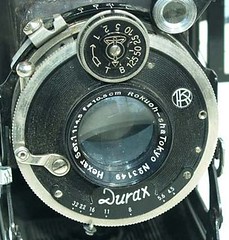
|
| Hexar Ser.1 10.5cm f/4.5 no.3149, on a Pearl. (Image rights) |
The Hexar Ser.1 was offered on the Pearl 6×9cm rollfilm folder from 1936 onwards, in 10.5cm, 11.5cm and 12cm focal lengths, all f/4.5. (It seems that the 11.5cm came first, followed by the other two.)
List of lenses:
- Hexar Ser.1 10.5cm f/4.5:
- Pearl, with Durax
- Luxury Pearl, with Durax, also advertised with Compur-Rapid
- Hexar Ser.1 11.5cm f/4.5:
- Hexar Ser.1 12cm f/4.5:
For 6×6cm TLR cameras
The Sakura-flex TLR prototypes have Hexar Ser.II 7.5cm f/3.5 taking and viewing lenses.
It is said that at least some examples of the Bikor-Flex, a TLR made in the early postwar period by Mori Seisakusho, have f/3.8 Hexar lenses.[3] These were perhaps the same Hexar Ser.II 7.5cm f/3.8 as mounted after 1945 on a few Semi Pearl (see below).
The Koniflex has a View Hexar 85mm f/3.0 viewing lens, and its tele attachment set has a View Tele-Hexar 135/4.
For 4.5×6cm rollfilm cameras

|

|
| Hexar 7.5cm f/4.5 lens no.38527, Durax shutter, on a Semi Pearl. Picture courtesy of Geoff Cliffe, Melbourne. (Image rights) | Hexar Ser.II 7.5cm f/3.8 lens no.4154, Compur-Rapid shutter, on a Semi Pearl. Picture courtesy of R. Hunter. (Image rights) |
The Hexar Ser.1 7.5cm f/4.5 was mounted on the Semi Pearl from the start of its production, at the beginning of 1938. The early examples have a chrome bezel, which was replaced by a black bezel after some time. The production started again after 1945, with Konishiroku instead of Rokuoh-sha markings.
Isolated examples of the Hexar Ser.II 7.5cm f/3.8 were mounted on Semi Pearl cameras after 1945. These were perhaps originally intended for use in a military camera with a Compur-Rapid shutter. The adaptation on Semi Pearl bodies, either with the Compur-Rapid or with the camera's regular Durax shutter, perhaps took place at the Konishiroku factory, but this was not an official version (see Semi Pearl).
From 1952, the Hexar f/4.5 lens was gradually replaced by a 75mm f/3.5 lens, which was used until 1959 on the Pearl series.
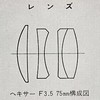
|
| Hexar 75mm f/3.5 scheme. (Image rights) |
List of lenses:
- Hexar Ser.1 7.5cm f/4.5:
- Semi Pearl, with Durax or Apus
- Hexar 7.5cm f/4.5 or 75mm f/4.5:
- Hexar Ser.II 7.5cm f/3.8:
- Semi Pearl, with Compur-Rapid or Durax
- Hexar 75mm f/3.5:
- Pearl II, with Konirapid-S
- Pearl IIB, with Durax-S
- Pearl III, with Konirapid-S
- Pearl IIIMX, with Seikosha-MX
- Pearl IIIL, with Seikosha-MXL
- Pearl IV, with Seikosha-MXL
For 4×6.5cm rollfilm cameras
The Hexar Ser.II was briefly mounted in 1932 on some Pearlette cameras, in f/6.3 maximal aperture, with a Pegasus shutter and fixed focusing. The focal length is presumably 7.5cm, but it is not engraved on the lens itself.[4]
The Hexar Ser.1 was mounted on the Luxury Pearlette released in late 1937, in f/4.5 maximum aperture, with an Apus shutter and a front-cell focusing mount.
For 3×4cm rollfilm cameras
The Hexar was made in 50mm focal length for the Baby Pearl 3×4cm folding camera. The Hexar Ser.1 50mm f/3.5 was offered from 1934 to the war, and its production was resumed after 1945. Very few examples were equipped from 1937 with f/3.8 lenses.
List of lenses (all on the Baby Pearl with Rox shutter):
- Hexar Ser.1 50mm f/4.5
- Hexar Ser.1 50mm f/3.8
- Hexar Ser.II 50mm f/3.8
For 24×36mm cameras
- Konica (I), IIB, IIBm
- Mamiya 35 I by Mamiya
- Yallu Flex by Yallu (predecessor of Aires)
To be continued
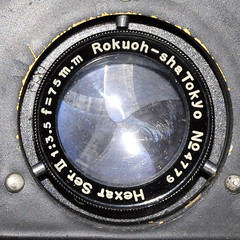
|
| Rokuoh-Sha Hexar Ser.II 75mm f/3.5 lens no.4779 fitted in a Konishiroku GSK-99 aerial camera. Picture by Dirk HR Spennemann. (Image rights) |
For military cameras
The Hexar Ser.II 75mm f/3.5 was used in the Army Type 99 Ultra Small Aerial Camera (GSK-99) which entered service in 1940. These cameras have a leaf shutter with a limited range of speeds. At least one of these lenses has been observed on a KOO-Tiyoko shutter giving 1/100, 1/200 and 1/400, surely made by Chiyoda Kōgaku Seikō.[5]
It is unclear if the Hexar Ser.II 7.5cm f/3.8 pictured in this page on a Semi Pearl with Compur-Rapid shutter was first developed for civilian or military applications.
Tele-Hexar lenses in leaf shutters, for hand cameras
Tele-Hexar lenses certainly has a different formula, probably inspired by the Tele-Tessar. The Tele-Hexar 30cm f/6.3 is found in leaf shutters, certainly for use on hand cameras. Two examples have been observed in a Compur shutter, of which at least one fits the Interchangeable Lily.[6] A third example is known in a KTI-Tiyoko shutter made by Chiyoda Kōgaku Seikō (predecessor of Minolta), the same as on the Military Lily, with a bayonet mount on the rear, perhaps for the Interchangeable Lily again.[7] These lenses were perhaps made for military use only. Other Tele-Hexar were made for aerial cameras (see below).
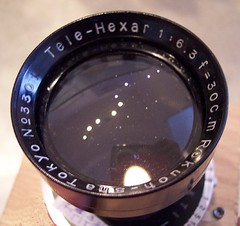 
| ||
   
| ||
| Tele-Hexar 30cm f/6.3 no.3301 in KTI-Tiyoko shutter, with bayonet mount. Pictures courtesy of Wenbiao Liang. (Image rights) | ||
Hexar interchangeable lenses, for rangefinder cameras
Konishiroku made a version of the Hexar 50mm f/3.5 lens in Leica screw mount. Before that, Hexar 50mm f/3.5 enlarging lenses were modified by the Reise company for use on the viewfinder-only Chiyoca. Isolated Hexar lenses are also known in presumed Leica screw mount, such as an Hexar Ser.1 15cm f/4.5 or a Tele-Hexar 40cm f/5.6.
For a detailed description of all these, see Konishiroku lenses in Leica screw mount.
Hexar lenses in focusing mount, for strut-folding cameras
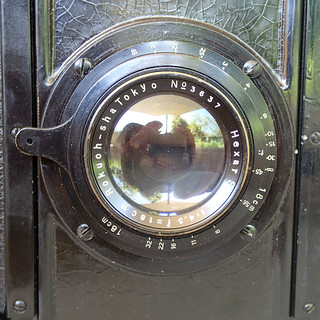
|
| Hexar Ser. 1 1:4.5 f=18 cm on a Rokuoh Sha Idea Spring image by Dirk HR Spennemann (Image rights) |
The Hexar was supplied on the Idea Spring strut-folder and its military version the Handheld Land Camera. These lenses are attached on a focusing mount, which also contains the diaphragm and has the focal length inscribed on the fixed and moving parts.
List of lenses:
- Hexar Ser.1 13.5cm f/4.5, on the tefuda size Idea Spring and Handheld Land Camera
- Hexar Ser.1 18cm f/4.5, on the kabine size Idea Spring and Handheld Land Camera[8]
- Hexar Ser.1 25 cm f/4.5, in the Navy Handheld Aerial Camera 25cm F-8 type aerial camera
Hexar barrel lenses
Early barrel lenses, for enlargers, view cameras or SLR cameras
The Hexar were also offered as barrel lenses. At an unknown date, an advertisement was offering the Hexar f/4.5 lenses in four focal lengths: 5cm (¥35), 7.5cm (¥40), 10.5cm (¥53) and 13.5cm (¥80).[9] The 10.5cm and 13.5cm were presented as suitable for general photography and for enlarging purpose, and the 5cm and 7.5cm were presented as enlarging lenses for smaller format negatives.
At least one example of the barrel Hexar Ser.1 13.5cm f/4.5 (no.12849) is known complete with its original box, inscribed Hexar 1:4.5 f=13.5cm Rokuoh-sha Tokyo MADE IN JAPAN inside the lid.[10]
Other focal lengths are reported, for use on view cameras or large format SLR cameras: 15cm, 18cm, 21cm, 25cm, 30cm and 36cm.[11] Actual examples of the Hexar Ser.1 21cm f/4.5[12] and Hexar Ser.1 25cm f/4.5[13] are confirmed to exist. It is not known if these all-purpose barrel lenses were still offered after World War II, but it is certain that the production of enlarging lenses did continue (see below).
At least one Hexar Ser.1 7.5cm f/4.5 has been observed in barrel mount.[14] This lens has an assorted plastic lens cap wearing the Rokuoh-sha logo, and it is said that it came in a dark blue cylindrical case. It might be a civilian enlarging lens, though military lenses with similar specifications were mounted on machine-gun cameras (see below).
A Hexar Ser.II 75mm f/3.5 is also known in barrel mount;[15] it is not known if it was intended for civilian or military use.
Barrel lenses for military use
7.5 cm and shorter, for gun cameras
The Type 89 Machine-gun Camera made by Rokuoh-sha was equipped with Hexar Ser.1 7.5cm f/4.5 and 4cm f/4.5 lenses.[16] It is also said that Hexar 45/2 lenses were mounted on fixed gun cameras (see Japanese aerial cameras).
Hexar Ser.1B 15cm f/4.5
The Hexar Ser.1B 15cm f/4.5 was mounted on the Type 99 Handheld Aerial Camera (15cm) used by the Japanese Navy. The lens is attached by four screws and has three prongs at the front for filter attachment.[17] The diaphragm is controlled by a lever, connected to the camera's large aperture ring.
Hexar Ser.IIA 20cm f/3.5
The standard lens for the Type 100 Small Aerial Camera (SK-100) was the Hexar Ser.IIA 20cm f/3.5, with a special three-lug bayonet at the rear. It has an aperture ring graduated from 3.5 to 22 and a three-pronged bayonet filter attachment at the front.
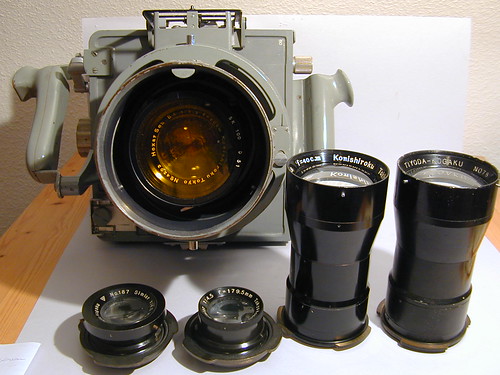
|
| Hexar Ser.IIA 20cm f/3.5 lens no.4203 on an SK-100 aerial camera, displayed with other lenses. Picture by eBayer Hbpartner. (Image rights) |
Hexar Ser.1 or Hexar.1 25cm f/4.5
The Nedinsco type and F-8 type Japanese aerial cameras came equipped with a Hexar Ser.1 25cm f/4.5 lens in the 1930s.[18]
The lens was first made with Rokuoh-sha markings, and later with Konishiroku markings,[19] presumably dating to 1943–1945. Some were produced with the terse engraving Hexar.1 4.5 25, together with Konishiroku's cherry blossom logo and a serial number with no prefix.[20]
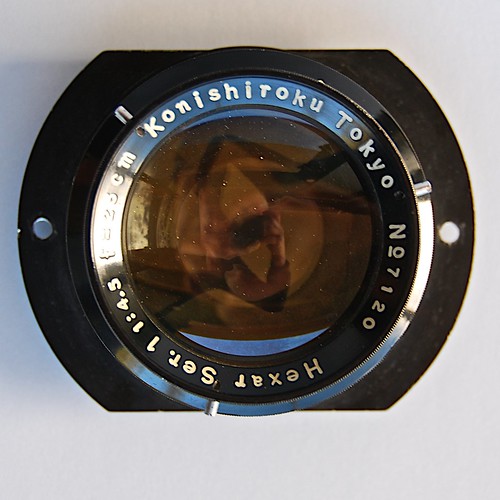
|
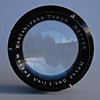 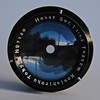 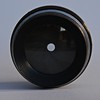 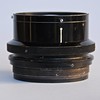 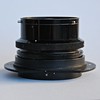  
|
| Konishiroku Hexar Ser.1 25cm f/4.5 lens no.7120. The mounting plate was certainly attached to an F-8 type aerial camera. Pictures by Dirk HR Spennemann. (Image rights) |
Tele-Hexar 40cm f/5.6
The Tele-Hexar 40cm f/5.6 was also made in bayonet mount for the SK-100.[21] It has no diaphragm or aperture control, and has three prongs at the front to attach the same filters as the 20cm f/3.5.
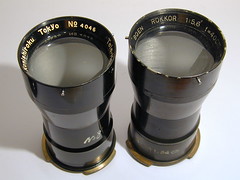 
|
| Tele-Hexar 40cm f/5.6 lens no.4046, for the SK-100 aerial camera, together with a Boen Rokkor. Pictures by eBayer Hbpartner. (Image rights) |
Hexar 50cm f/5
The Hexar 50cm f/5 was used on special aerial cameras, such as the Type 4 displayed in the Smithsonian National Air and Space Museum.[22] One example has been observed with Konishiroku Tokyo markings; it consists of a mere lens head with three prongs to attach a filter, and came in a black or dark blue cylindrical case.[23] The short length of the lens head makes it implausible that it retains the original four-element Hexar lens scheme, and it is probable that this lens is an achromatic doublet (like some long focal Leica Telyt).
Later enlarging lenses
Hexar enlarging lenses continued to be made after 1945, notably in 50mm f/3.5 and 75mm f/3.5, in various barrels.[24] As said above, some of the 50mm f/3.5 were modified by Reise for the viewfinder-only Chiyoca 35.
See also
- Lily (metal and tropical)
- Pearl (6×9 self-erecting)
- Baby Pearl
- Semi Pearl
- Pearl (I), II and III
- Pearl IV
- Sakura-flex
- Konica (I), II and III
- Koniflex
- Yallu Flex
- Konishiroku lenses in Leica screw mount
- Japanese aerial cameras
- Type 99 Ultra Small Aerial Camera (GSK-99)
Notes
- ↑ Yazawa, p.13 of Camera Collectors' News no.56. See also this page of the R. Konishi website.
- ↑ Example pictured in Tanaka, p.89 of Kurashikku Kamera Senka no.10.
- ↑ See Bikor-Flex.
- ↑ Example pictured in this page at R.Konishi Rokuoh-sha.
- ↑ R. Konishi website.
- ↑ Lens pictured in Baird, p.82, together with an Interchangeable Lily, and lens observed in an online auction.
- ↑ Lens pictured in this page.
- ↑ Documented lens serial numbers: Rokuoh-Sha no. 4343 (eBay nº 110517330896 / Apr 16, 2010)
- ↑ Advertisement reproduced in Inoue, p.128 of Kurashikku Kamera Senka no.14, and in an incomplete form in Tanaka, p.88 of Kurashikku Kamera Senka no.10.
- ↑ Example pictured in this page at R.Konishi Rokuoh-sha.
- ↑ See this page at R. Konishi Rokuoh-sha.
- ↑ Rokuoh-Sha Tokyo Hexar Ser.1 21cm f/4.5 no.34701 pictured here at ksmt.com;
- ↑ Rokuoh-Sha Tokyo Hexar Ser.1 25cm f/4.5 no.5259 pictured in Yazawa, p.15 of Camera Collectors' News no.56.
- ↑ Rokuoh-Sha Tokyo Hexar Ser.1 7.5cm f/4.5 lens no.18321 pictured in this page at Aho Ressha Pictorial. The page says that the lens is 18mm in diameter, but does not specify where this diameter was measured.
- ↑ Rokuoh-Sha Tokyo Hexar Ser.II 75mm f/3.5 lens no.4475 pictured in this page at R.Konishi Rokuoh-sha.—Rokuoh-Sha Tokyo Hexar Ser.II 75mm f/3.5 lens no. 5486 (Photographica Collection Dirk HR Spennemann)
- ↑ Specifications in this page at R.Konishi Rokuoh-sha, and in Sugiyama, item 6015.
- ↑ Konishiroku Tokyo Hexar Ser.1B 15cm f/4.5 pictured in this page at Kore Nāni.
- ↑ Rokuoh-sha Tokyo Hexar Ser.1 25cm f/4.5 lens no.5382 Worth Point entry, based on a 2007 eBay sale.
- ↑ Konishiroku Hexar Series 1, 25cm f=1:4.5.
- ↑ Lens no.7962 pictured in this page at R.Konishi Rokuoh-sha, and lens no.7733 or 7753 observed on an F-8 type aerial camera.
- ↑ Konishiroku Tokyo Tele-Hexar 40cm f/5.6 no.5014 (WW2 Military Japanese Aerial Camera SK-100).
- ↑ Hexar 50cm lens no.1020 reported in this page of the NASM.
- ↑ Konishiroku Tokyo Hexar 50cm f/5 no.3152, observed in an online auction.
- ↑ An enlarging 50mm f/3.5 is pictured in this page at Red Book Nikkor. Enlarging 50mm f/3.5 and 75mm f/4.5 have been observed in online auctions.
Bibliography
- Baird, John R. The Japanese Camera. Yakima, WA: Historical Camera Publications, 1990. ISBN 1-879561-02-6. Pp.60–1 and 82.
- Lewis, Gordon, ed. The History of the Japanese Camera. Rochester, N.Y.: George Eastman House, International Museum of Photography & Film, 1991. ISBN 0-935398-17-1 (paper), 0-935398-16-3 (hard).
- Inoue, Mitsuo (井上光朗). "Shashin renzu no yoake. Renzu-ya Funsenki" (写真レンズの夜明け・レンズ屋奮戦記, Dawn of the photographic lens — Fierce war tales between lens shops). Kamera Rebyū: Kurashikku Kamera Senka (カメラレビュー クラシックカメラ専科) / Camera Review: All about Historical Cameras no.14, October 1989. No ISBN number. Rikō kamera no subete (リコーカメラのすべて, special issue on Ricoh). Pp.128–132.
- Sakai Shūichi (酒井修一). "'Anbako' kara 'ōtofōkasu' he: kamera no hensen to tomo ni ayunda 114-nen" (「暗函」から「オートフォーカス」へ・カメラの変遷と共に歩んだ114年, From 'camera obscura' to 'autofocus': 114 years of camera evolution). Kamera Rebyū: Kurashikku Kamera Senka (カメラレビュー クラシックカメラ専科) / Camera Review: All about Historical Cameras no.10, September 1987. No ISBN number. Konishiroku kamera no rekishi (小西六カメラの歴史, special issue on Konishiroku). Pp.8–13.
- Shashin to tomo ni hyaku-nen (写真とともに百年, 0ne hundred years of photography). Konishiroku Shashin Kōgyō, 1973. Pp.403–4, reproduced in this page of the R. Konishi Rokuoh-sha website].
- Sugiyama, Kōichi (杉山浩一); Naoi, Hiroaki (直井浩明); Bullock, John R. The Collector's Guide to Japanese Cameras. 国産カメラ図鑑 (Kokusan kamera zukan). Tokyo: Asahi Sonorama, 1985. ISBN 4-257-03187-5.
- Tanaka Masao (田中政雄). "Hekisā F4.5 no tanjō" (ヘキサーF4.5の誕生, The birth of the Hexar f/4.5). Kamera Rebyū: Kurashikku Kamera Senka (カメラレビュー クラシックカメラ専科) / Camera Review: All about Historical Cameras no.10, September 1987. No ISBN number. Konishiroku kamera no rekishi (小西六カメラの歴史, special issue on Konishiroku). Pp.88–9.
- Yazawa Seiichirō (矢沢征一郎). "Shashin renzu hattatsu-shi dai-12-kai: Kokusan renzu no rekishi (zenpen)" (写真レンズ発達史第12回・国産レンズの歴史[前編], History of the development of photographic lenses no.12: History of the Japanese lenses [first part]). In Camera Collectors' News no.56 (February 1982). Nishinomiya: Camera Collectors News-sha. Pp.11–6.
Links
In Japanese:
- Pages of the R. Konishi Rokuoh-sha website:
- Hexar Ser.1 7.5cm f/4.5, apparently in 18mm screw mount, at Aho Ressha Pictorial
- Hexar Ser.1 21cm f/4.5 barrel lens at ksmt.com
- Tele-Hexar 40cm f/5.6 lens, adapted on a bellows, in Koujiya Camera's blog
- September 2008 meeting report of the Nikon Kenkyukai (English version) at Akiyama Michio's Red Book Nikkor, showing a Hexar 50mm f/3.5 enlarging lens